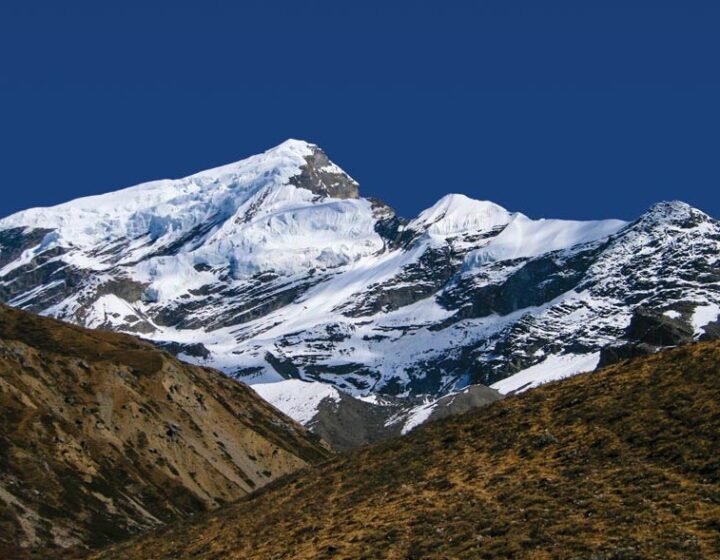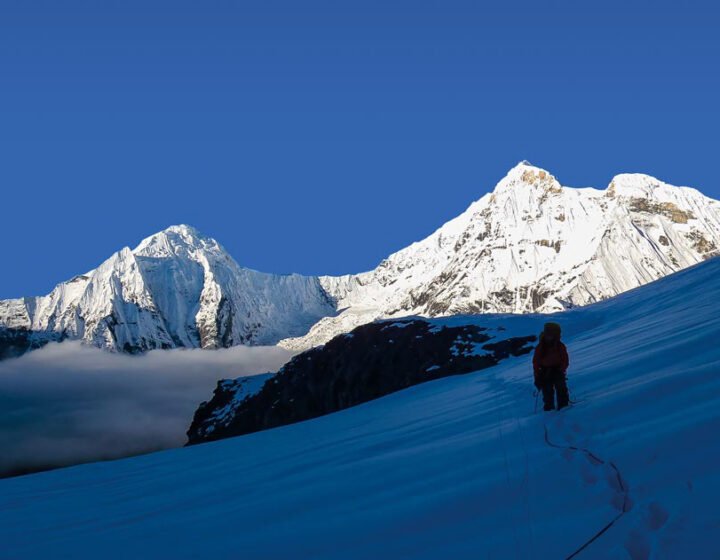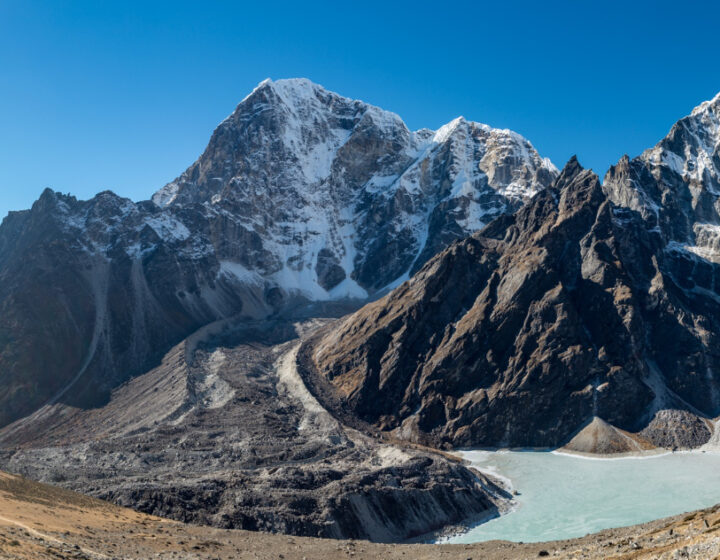- Details
Detailed itinerary
Itinerary- Tour Includes/Excludes
- Useful Info
- FAQ
Trip overview
Lobuche east peak climbing provides a fantastic opportunity for 6000 meters of peak climbing in conjunction with the walk to EBC. Apart from that, Lobuche peak climbing provides an excellent option for peak climbing in the Everest region. This east summit of Lobuche is located between the Chola pass and Everest base camp. Lobuche features twin peaks on its east and west flanks. We climb over less-traveled terrain in the Everest zone to reach the Lobuche base camp. As you travel to the southern base camp at 5500 meters, you will be rewarded with amazing views of Amadablam, Tawache, and other beautiful mountains. The views of Mount Everest and the surrounding peaks from the Lobuche top are just beyond words.
Our experienced mountain guides organize a climbing clinic course at a base camp. This will ensure that you develop the necessary abilities and confidence to attain your goal. You do not need any prior climbing expertise to participate in this Lobuche east peak climbing trip in Nepal. However, prior outdoor experience and a healthy level of fitness are highly recommended. The better your fitness, the more you will appreciate your adventure.
We stopped at a local teahouse on our way up to the base camp of Lobuche peak. While staying at the teahouse, the teahouse staff prepares all meals, including full board meals of your choice, and serves you in a decent manner. Following the same path, we reach the base camp on the higher altitude of this Lobuche east peak climbing excursion, where we will manage to stay in a tented camp. Even though we are at 5000 meters, we have a staff who prepares all of our meals. in absence of a lodge and teahouse we have to completely rely on the cook staff who are available with us.
As a precaution, we carry oxygen as well as comprehensive first aid equipment. Without a doubt, we ensure that there is enough trek crew, including a porter for each trekker. As result, our climbers get relief from carrying all their equipment and at the same time, this creates employment opportunities for porters and also helps them in earning.
Highlights
- Everest Base Camp Hike
- The stunning view from Kalapatthar, often known as the Everest perspective,
- Lobuche Peak, at 6,119 m, is one of Nepal’s most popular climbing peaks.
- Overnight tent camping at Lobuche Base Camp and High Camp at Lobuche Peak.
- Climbing in the Himalayas is an unforgettable experience.
- Mount Everest view.
Itinerary
Day 1: Arrival to KathmanduOur representatives will meet you at the airport today, as planned. They'll be waiting for you at the entry point. They'll transport you to your hotel and help you get the keys to your room after a pleasant welcome and introduction.
The second day of our Lobuche East Peak Climbing trip in Nepal will be spent resting and exploring Kathmandu City. We'll go to Pashupatinath Temple and pray there first thing in the morning. We'll then drive to Boudhanath Stupa, which is 2.1 kilometers away from Pashupati.
There are prayer wheels and flags all throughout the religious sanctuary. You'll also hear chants and instruments being played in the stupa.
We'll proceed to Kathmandu Durbar Square shortly after visiting the monasteries. The courtyard, wooden temples, stone statues, and antiquities may all be seen when visiting Durbar Square. After the sighting, we'll return to the hotel, where you can have dinner and rest.
We'll fly to Tribhuvan Airport at dawn and take a flight to Lukla. We'll be able to see rolling hills and lush meadows along the route thanks to the clear sky after sunrise. The flight will last about 30 minutes before arriving at Lukla, the gateway to Mount Everest.
We'll make a brief stop in town for breakfast. From there, we'll begin our journey to Phakding by ascending the hillside trail along the left bank of the Dudh Koshi River. We'll arrive in Phakding after a few uphill and downhill treks. Stay the night at a village lodge.
We'll return to the track that runs alongside the Dudh Koshi River shortly after breakfast. We'll enter the dense forest covered with pine and fir after following the river valley above and crossing the suspension bridge.
We'll pass through various villages on the way to town, including Manjo. The trek is difficult after entering the Sagarmatha National Park, especially with the lowering atmospheric pressure.
Most trekkers experience altitude sickness at this point, so you'll need to be cautious as you climb the trail. It takes around two hours to hike up the steep hill, with various highs and lows, to reach the famous Sherpa settlement of Namche Bazaar.
After the long and hard journey to Namche, it's good to relax and explore the town. As a result, rather than traveling miles to Dingboche, we'll take a short walk to the Everest View Hotel. This trip will help us acclimate while also providing us with an amazing vista.
We'll continue trekking out of the hamlet on a difficult, ascending trail. Our path descends the hill and crosses the ridge after strolling alongside the ancient Mani wall. From Phunki Tenga, we follow a zigzagged path with a few ups and downs. Following a steady uphill walk, the last two hours will be a bit frenetic.
Tengboche, at 12,677 feet, has a beautiful view of Ama Dablam. From the hilltop across Imja Khola, you can also photograph the stunning green hills and narrow gorges. In the afternoon, we'll visit the monastery and even pay our respects by staying
The trek to Dingboche is moderately difficult, with most of the way's trail upward. The trek leaves Tengboche village and heads through rhododendron and pine woodland to Imja Khola. We'll go past the Mani stone wall to the Sherpa settlement of Pangboche after crossing the suspension bridge.
The walk offers stunning views of sparkling snow peaks such as Ama Dablam and Lhotse. We'll arrive in the distant settlement of Dingboche after a few more hours of travel. Stay the night in a tea house.
We'll continue our adventure after a delicious breakfast at a tea house in Lobuche. The day begins with a difficult ascent off the side of a hill into the broad valley of Imja. We can see the glittering Ama Dablam and Lhotse mountains from kilometers away as we walk the difficult terrain above Chukhung. We'll arrive in Lobuche after a few more hours of trekking through rocks and pebbles.
The trek to Gorak Shep appears to be short, with only a 2.8-mile track. However, due to the high altitude and the gravel path, the climb may take 3–4 hours. We'll arrive at Gorak Shep after a good fight against the loose rocks and rugged hills.
After lunch, we resume our ascent of the steep trail that runs alongside stony dunes and glacial moraine. This section of the journey is a little tough, with rising heights and debris, so we'll have to be cautious. We'll see Mt. Everest, as well as the surrounding Cho Oyu and Nuptse, when we get to the base of the Khumbu Icefall.
We'll start climbing Kala Patthar from Gorak Shep the next day. Because the trail is steep and rocky here, it will take us approximately 2-3 hours to reach the ridge. From the hilltop, we can see high mountains, glacial lakes, and landscapes from the hilltop.
We'll descend the trail to Gorak Shep shortly after we finish sightseeing. We'll stop in the village for lunch before returning to Lobuche. Although the path is easy to walk with a constant decline, the hike still takes 2-3 hours. Stay overnight in a tea house.
Our journey to Lobuche Peak Base Camp begins with an ascent uphill and across tough terrain. We will start hiking early in the morning because of the longer trial We then ascend the difficult trail to cross the Lobuche Glacier, from which we can see Cholatse and Thamserku. We'll arrive at the Lobuche Base Camp after climbing for about 6 hours. Our Sherpa crew will set up the tent where we will spend the night at base camp.
We'll head for the uphill trail after eating breakfast and stretching our legs. Our path leads to the High Camp via a narrow lane and a snow-covered ridge.
We'll wear crampons because the trail to high camp is icy and snowy. We'll also use an ice axe to scale the icy cliff. We'll reach the campsite at 5,400 meters by following the instructions of a walking guide.
We'll relax and re-energize ourselves for the big day because the climb to high camp is difficult and taxing. Before ascending to the summit, medical specialists will examine our health to ensure our safety. The hike guide will also provide us with training.
We'll ascend the glacier using an ice axe and a fixed rope. We'll follow the trek guide's directions and stick together with the crew the entire time. They'll lead the way via the snowy ridge and sharp dips.
The hike from Lobuche Base Camp to the peak takes about 4 hours. However, once at the summit, the peak provides amazing views of Ama Dablam, Cholatse, Thamserku, and Kantega.
We'll retrace our steps back to camp after a quick stop at the crest. The trail going downward means the trekking will be easier this time.
We'll approach Pangboche through a pleasant descent below the hill and through the settlement.
We'll then travel through an alpine woodland of rhododendron and juniper trees. After around 5–6 hours of hiking, we'll arrive at the remote settlement of Pangboche. On the route, we may see memorials to climbers who died on the peak. We'll stay in a tea house in Pangboche.
We'll start descending the trail from Pangboche to Namche Bazaar after breakfast. The day will begin with a walk through rhododendron and juniper forest. We follow the path to the suspension bridge and through the pine forest after crossing the Dudh Koshi River.
Along the way, we can see glittering snow-covered mountains and deep valleys, providing a beautiful backdrop. Our trail follows a forested slope with numerous twists and turns. The entire journey takes us 6-7 hours before we arrive in town.
The trek from Namche to Lukla is straightforward, with most of the trail heading downward. It progressively descends the steep slopes and over multiple suspension bridges before arriving in town.
The terrain flattens out after we cross the Hillary suspension bridge, making it easy for us to traverse. Finally, after a 7-hour journey, we will arrive in the picturesque settlement of Lukla, which will also be our home for the night.
The final day of Lobuche East Peak, with a no longer stretched trail Climbing is pretty enjoyable. We'll dash down to the Lukla airport and board the flight after breakfast in a tea house. For over 30 minutes, the ride provides us with a magnificent vista of the Himalayan ranges, rolling hills, and waterfalls. After leaving airport, our personnel will drive you back to the hotel so you can rest.
According to the flight schedule, our representatives will transport you back to the airport on this day. They will also assist you with the documentation if necessary.
Included
- All domestic and international flight arrival and departure transfers.
- According to the plan, standard hotel stays in Kathmandu on a twin-share bed-and-breakfast basis.
- The Lobuche east peak climbing schedule includes a welcome feast of local Nepali cuisine.
- The schedule includes a half-day guided city tour with world heritage entrance fees.
- Domestic flights and airport taxes are included in the Lobuche peak climbing schedule.
- Full board meals (open / choice menu) while trekking to Lobuche (Breakfast, Lunch, Dinner).
- Responsible for trekking and climbing with a porter to trekker ratio of one to one.
- While climbing, our cook prepares freshly cooked full-board meals.
- While on a Lobuche east peak climbing excursion, I drank properly boiled drinking water, tea, and coffee.
- Accommodation in a tea house or lodge when climbing Lobuche Peak and visiting Everest Base Camp.
- Tented camp accommodation while climbing Lobuche East Peak.
- All personal and group climbing equipment, such as the LA SPORTIVA climbing boot, the Black Diamond harness, Jumar, the figure of eight, Carabiner, helmet, ice axe, rope, and all necessary camping gear, such as member tents, are provided.
- Lobuche east peak climbing permit royalties, as well as various government charges
- Climbing Clinic Course at Lobuche Peak Base Camp
- Trip Equipment - sleeping bag, fleece inner liner, down jacket, rain poncho, and other items for usage on the trip
- Professional local Trek Leader / Guide with Wilderness First Aid training.
- Climbing guide with all allowances and expenditures, camping crew with porter, all necessary trek gear, and sufficient insurance.
- The climbing certificate for Lobuche East Peak was issued the Nepal Government's respective body.
- Everest National Park trekking permit for the Lobuche peak climbing expedition.
Not Included
- Nepal entry visa fees, any type of travel insurance.
- International flight and airport tax
- In cities, all drinks and main meals are included.
- Personal expenses such as a hot shower, battery charge, phone, and beverage drinks
Useful Info
- You must be aware of the season, make sure that you must be careful while traveling through December and mid-February.
- Be ready for altitude changes and keep buffering day to minimize the risk.
- Remember to keep a climbing permit.
- Bring warm clothes with you, especially the zipper ones.
- Remember to Hydrate yourself while climbing so always keep a water bottle with you.
- Try to keep a light backpack with essential equipment and clothes.
- Follow the advice from experts and guides.
- In cases of special medical situations. Please take your doctor’s advice and if you are physically and mentally unwell then please avoid climbing.
FAQs
-
What level of climbing experience do I need to conquer Lobuche Peak?
Lobuche Peak is a somewhat tough alpine climb. You should be comfortable walking with an ice axe, using crampons, and performing self-arrests. Summit day will necessitate a pre-dawn "alpine start," with your crew moving efficiently on established lines and in teams across limited ridges. The ascent is breathtaking! Your guides will go over the necessary abilities, but it is critical that you be familiar with your climbing equipment (harness, crampons, and ice axe) prior to the trip.
-
Do you have access to radio communications in case of an emergency?
Our principal source of communication with Kathmandu and the rest of the world is our satellite phone. We will also carry radios and utilize cell phones from most of the trek's destinations, as well as from higher elevations on Lobuche Peak.
-
Can we take showers on the way? How do we keep ourselves clean?
Throughout the Khumbu, hot showers with gravity-fed water heated on gas burners are offered. In the lower villages, such as Namche, solar heated showers are available in your own lodge rooms. Washing facilities grow more basic as you ascend, but they are always available. Showers are less likely to be utilized in higher altitudes due to the frigid outdoor temperatures. Every day, our Sherpa crew also gives each client with a little basin of warm washing water. Before each meal, warm cleansing water and hand soap are supplied (and we demand you use it!).








